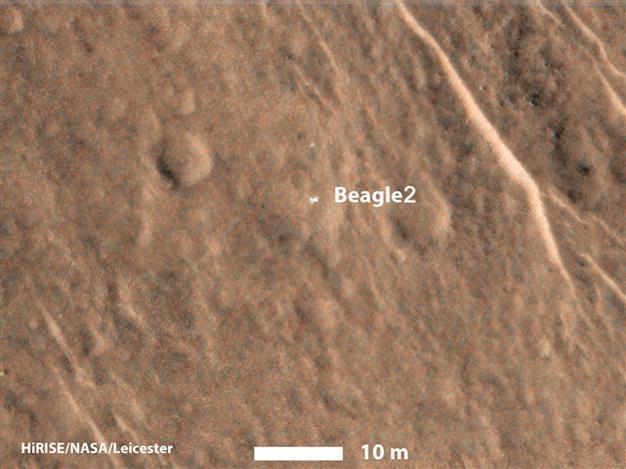Long-lost British space probe found on Mars: agency
LONDON - Agence France-Presse

In this image provided by NASA an annotated image shows a bright feature interpreted as the United Kingdom's Beagle 2 Lander with solar arrays at least partially deployed on the surface of Mars. AP Photo
A British-built space probe that disappeared without trace more than a decade ago has been spotted on the surface of Mars, the UK Space Agency said on Jan. 16.
The Beagle 2 lander was found partially deployed with one of its parachutes still attached in images taken by NASA's Mars Reconnaissance Orbiter (MRO).
Scientists said it would be impossible to renew contact or retrieve data from the machine, which was lost without trace on December 26, 2003.
"These images are consistent with the Beagle 2 having successfully landed on Mars," David Parker, head of the UK Space Agency, told reporters in London.
Parker said the find vindicated the hard work behind the ill-fated mission, which has remained a mystery.
The driving force behind the project, planetary scientist Colin Pillinger, died last year not knowing whether his rover landed successfully or not.
"To be frank, I had all but given up hope of ever knowing what happened to Beagle 2," Parker said.
"Every Christmas Day since 2003 I have wondered what happened to Beagle 2," he added.
The mission gripped Britain and there were emotional reactions to the presumed destruction of Beagle 2 during a landing sequence followed around the country.
Named after Charles Darwin's ship HMS Beagle, Beagle 2 was shaped like a giant pocket watch and opened to reveal solar panels, a robotic arm and research equipment designed to search for signs of life.
It rode piggy-back to Mars aboard the European Space Agency's Mars Express in 2003, taking off from Russia's Baikonur cosmodrome in the first European mission to explore another planet.
The mission's call-sign was composed by the Britpop band Blur, and the "test card" used to calibrate the probe's cameras after the landing was painted by British artist Damien Hirst.
After detaching from Mars Express on December 26, it was never heard from again and scientists had said it may have burnt up in the planet's atmosphere.
"It was a great pity we couldn't have delivered the world-class science Beagle 2 may have brought and even sadder that Colin and other colleagues who died in 2014 didn't live to see the discovery that Beagle 2 made it to Mars," Parker said.
In the early days and weeks after it disappeared, Pillinger remained relentlessly optimistic and his terrier-like enthusiasm made him a popular figure on British television.
The European Space Agency's director general Jean-Jacques Dordain said meanwhile at a press briefing in Paris that "what was viewed as a failure 11 years ago in fact turns out not to be a total failure".
"At least there was a landing on Mars," he added.
In London, Parker said: "The history of space exploration is marked by both success and failure.
"This finding makes the case that Beagle 2 was more of a success than we previously knew and undoubtedly an important step in Europe's continuing exploration of Mars," he added.
The UK space agency said in a statement that the images showed the lander's pilot chute still attached and its main parachute nearby in the intended landing area -- the Isidis Planitia basin.
"Unfortunately given the partial deployment... it would not be possible to revive Beagle 2 and recover data from it," the UK space agency said in a statement.
